Contents
halasana
„plow“

 instructions and details with working links as PDF for download/print
instructions and details with working links as PDF for download/print
Detailfotos
seen dorsally: back stretched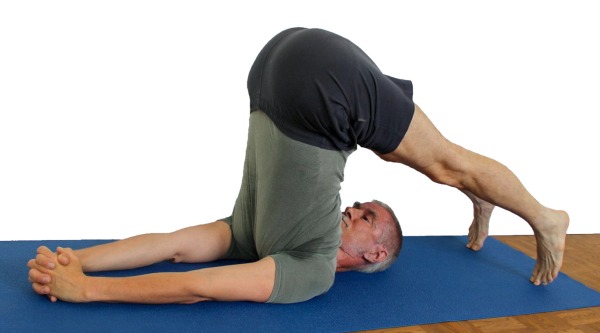 | optional: supporting hands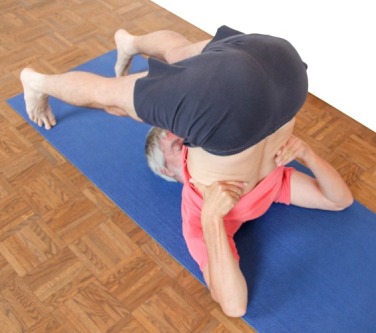 |
Feedback: We’d love to hear what you think about this description, give us feedback at:
postmeister@yogabook.org
Last modified: 30.12.2018
Name: halasana
trivial name: plow
Level: FA
- classification
- contraindications
- effects
- preparation
- follow-up
- derived asanas
- similar asanas
- diagnostics
- instructions
- details
- variants
Classification
classic: lying pose
psychomental: introverting, calming
physiological: strengthens the back muscles, stretches the cervical part of the autochthonous muscles and the hamstrings
Contraindication
Poses and movements that convexly round (flex) the spine are contraindicated in the case of acute disc herniation in the lumbar spine and can trigger pain and have a detrimental effect on the alleviation of symptoms; this will inevitably be the case in this pose in less flexible people. In addition, taking the pose without rounding the back presents a challenge. In the case of disc herniations in the cervical spine, this pose is contraindicated completely.
Effects
- (552) Strengthening of the quadratus lumborum
- (602) Strengthening of the erector spinae
- (632) Strengthening the muscles of the thoracic spine
- (642) Strengthening the muscles of the lumbar spine
- (181) Stretching the neck / cervical spine in the direction of flexion
- (291) Stretching the trapezius
- (246) Shoulder joint: stretching for retroversion
- (621) Stretching the neck / cervical spine
- (721) Stretching the hamstrings
Preparation
Back of the leg: halasana requires fairly flexible hamstrings. Restrictions in flexibility here, just like those in the cervical and upper thoracic spine, will effectively prevent the back from stretching. Helpful preparations
- uttanasana THE standard to warm up and stretch the hamstrings
- prasarita padottanasana similar to uttanasana
- downface dog good preparation with a strong tilt of the pelvis
- hip opener 5 preparation that goes beyond uttanasana
- parsvottanasana preparation that goes beyond uttanasana
- parivrtta trikonasana as a very effective and efficient stretch of the hamstrings
- parivrtta ardha chandrasana as a very effective and efficient stretch for the hamstrings
- downface dog is also a good preparation for the hamstrings group when the pelvis is tilted forcefully
Neck: halasana requires a fairly flexible cervical spine. Restrictions in flexibility here will effectively prevent the back from stretching, just like in the hamstrings. Helpful preparations:
- headstand is a good way to warm up the neck muscles. These muscles have a „slightly different character“ to the muscles that move the extremities; they have more of a „holding“ character, which is why they react positively to being warmed up first before stretching, as in halasana
- shoulderstand is very similar in terms of the cervical spine
- karnapidasana is very similar in terms of the cervical spine
Depending on the flexibility of the cervical spine and the hamstrings, the stretching of the back is a task that can only be solved with a great deal of sustainability; helpful preparations in addition to the flexibility exercises:
- „desk“ variation of uttanasana
- rectangular uttanasana
- warrior 3 pose
- headstand variation: lower legs bent
Follow-up
Basically, discomfort can occur in the neck in halasana, which may persist beyond the pose:
- sitting twist
- maricyasana 1
- maricyasana 3
- parivrtta trikonasana, looking straight ahead or upwards
If the back muscles feel strained or tense after halasana, this can help:
- karnapidasana
- virasana forward bend (child’s pose)
- parsva uttanasana
- parsva upavista konasana
- parivrtta trikonasana
- parsvottanasana
- half lotus forward bend
Derived asanas:
supta konasana, parsva halasana
Similar asanas:
All reverse forward bends with a bent cervical spine are similar:
Similar to the requirement to straighten the back with flexion in the hip joints:
- „desk“ variation of uttanasana
- rectangular uttanasana
- warrior 3 pose
- upavista konasana in the „pull on the feet“ variation
Diagnostics (no.)
(680) Oesophagus/stomach/intestine:
A disturbed closure function of the stomach or oesophagus can be particularly noticeable here, as can an overfilled stomach or intestine, which can exert pressure on the heart and lungs. Symptoms of a Roemheld’s syndrome may worsen.
Various types of neck complaints can become noticeable in halasana, from simple muscular tension to neuroradicular pain in the case of disc herniations.
- Simple stretching sensations can be tolerated to a small extent. If the stretching sensation becomes too great, it may not disappear immediately after stopping the pose.
- If there is a disc herniation (protrusion, herniation, etc.), pressure on a nerve root can lead to neurological symptoms such as numbness, pain, sensory disturbance, paraesthesia). For this reason, halasana is contraindicated for cervical spine disc herniations. Disc herniations in the lumbar spine are a contraindication if the flexibility of the cervical spine and the hamstrings is not so good that the back can be stretched. And even then, taking the pose is a major challenge because the back is usually curved. If you have a known disc herniation in the lumbar spine, halasana should therefore only be performed after a longer symptom-free interval and only after consultation with the treating therapist. In case of a disc herniation in the cervical spine abstain from halasana completely.
(724) Back of the leg:
In halasana, irritation of the area of origin of the hamstrings, a Proximal Hamstring Tendinopathy (PHT), may be noticeable. Although the area of origin of the hamstrings is stressed far less than in uttanasana or in handstand upswing, for example, and is not subjected to momentum, irritation and strains can also occur here, see also FAQ.
Variants:
Support yourself with your hands
Instructions
- Take karnapidasana, which is also recommended as a preliminary exercise.
- Straighten your legs.
- If necessary, support your back with your hands and use your back muscles to stretch your back as far as possible, ideally in a vertical position.
Details
- Building up from karnapidasana has several advantages: karnapidasana stretches the muscles of the upper back and neck, which is an important prerequisite for the success of halasana. It is recommended to hold karnapidasana for 30 seconds to approx. 3 minutes beforehand, depending on the condition of the back and cervical spine. When the back is stretched, it is very easy to feel the vertebrae with the fingers of one hand and assess how the back stretches. An indication for a stretched back is the entry of the spinous processes of the vertebrae that previously emerged from the body. The extent to which the vertebrae move outwards allows conclusions to be drawn about the restriction of flexibility of the back and, to a lesser extent, the strength of the back (erector spinae).
- In halasana, the vertebrae of at least the middle and lower back, which emerge a little from the body in karnapidasana, should fully re-enter the body. Each vertebra that still emerges in halasana indicates an area that is still curved. This can be easily observed and assessed visually by an outsider as well as by the performer in the pose with the fingers of one hand.
- The ability to stretch the back is restricted from both ends of the spine:
- from the cervical spine, which, when less flexible, restricts the extent to which the upper thoracic spine (close to the floor) can be straightened
- the pelvis, in that the flexibility of the hamstrings determines the extent to which the sacrum and subsequently the lumbar spine can be brought closer to the vertical. Depending on how these two factors coincide, it may be impossible to straighten the spine even approximately. In these cases, the work begins with finding a clear (tangible and visible) differentiation between the attempt to straighten the spine and the relaxation of the back muscles typical of karnapidasana, so that it becomes clear how to work. Of course, the back will not be able to be straight until both prerequisites, flexible hamstrings and flexible cervical spine, are present at the same time.
- The pelvis, which is clearly inclined towards the vertical in karnapidasana, is straightened more towards the vertical in halasana under the above conditions. Halasana is meant as a vertically stretched back, so it is clear that the pelvis is above the shoulders.
- In halasana, the pelvis lifts in relation to karnapidasana and moves towards the ceiling, so it makes a straightening and lifting movement at the same time in the transition to halasana.
- If the hamstrings are very immobile, the feet may need to be placed on a support such as a block or even a chair to avoid too much discomfort to the cervical spine.
- Of course, the same things apply to relieving the cervical spine as for karnapidasana and sarvangasana.
- If there is uncomfortable pressure on the 7th cervical vertebra (vertebra prominens), support the shoulder so high that the pressure is reduced to a tolerable level or even disappears. The material of the support is of secondary importance. It is important that the head is lower than the shoulder area in order to reduce the flexion requirement on the cervical spine. It is also very helpful to leave the C7 free, i.e. to leave it out of the support, for example by placing two shoulder stand plates together at an angle so that they leave space for the C7.
Known problems that can occur even when performed correctly
Inability to place the feet on the floor
As described above, depending on the flexibility of the cervical spine and the hamstrings, the toes may not be able to reach the floor. In this case, use an appropriate support underneath.
Discomfort in the cervical spine
Discomfort in the cervical spine, however it is caused, is a signal to modify the pose so that it no longer occurs or occurs only minimally.
Variants
Support yourself with your hands

Prevents the feet from slipping and helps to straighten the back
Instructions
- Take the pose as described above, but press the centre of the back towards the feet with both hands.
Details
- It is important to straighten your back and not allow your pelvis to move beyond your shoulders towards your feet. If the upper body is only pressed towards the feet with the hands, this does not automatically result in a straight back. This can only occur when the back is stretched with the strength of the autochthonous back muscles and the pelvis is straightened towards the vertical. If the pelvis moves beyond the shoulder area, there is a great risk that the back will not straighten, but the demand for flexibility on the cervical spine will be so great that this can no longer be achieved safely.
Feet against the wall
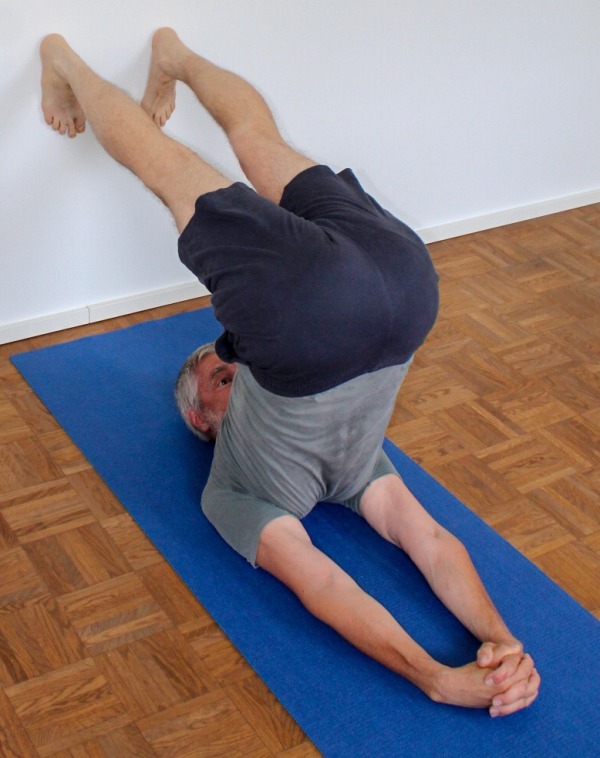
Prevents the feet from slipping
Instructions
- Take the pose as described above, but place your feet against the wall so that you can stretch your back powerfully without having to worry about slipping.
Details
- In halasana, the calves push the pelvis away when the balls of the feet are on the floor. The feet can be placed against the wall to prevent any slipping and to be able to exert unlimited force. In the case of very severe restrictions in the flexibility of the cervical spine and the hamstrings, the feet can also be placed on the wall above the floor to make it easier to stretch the back, especially when the aim is to first find the right type of work for the back muscles, i.e. to differentiate between the condition of the non-working back muscles (erector spinae in many of its parts) and that of those working in the right way. The heels mainly press against the wall. You can then try to stretch the back without withholding strength.
- This support can be combined with the next variation, resting the thighs on a chair.
Supported with a chair

facilitates stretching of the back
Instructions
- Pick up a chair. Place your head under the chair from one side and your back on the floor in front of it.
- Bend the legs, swing the legs back up and place them on the seat of the chair, lifting the upper body off the floor and moving towards the vertical.
- Let your legs rest passively on the chair and stretch your back using the strength of your erector spinae.
Details
- This variation is a significant softening of the basic pose. As described there, for most people who are not particularly flexible, the restrictions in the thoracic spine/spinal column and hamstrings force a curve in the back. If the legs are on a chair and are therefore roughly horizontal instead of standing at a significant angle with the feet on the floor, this provides significant relief and reduces the strain. The cervical spine has to bend a little less and the backs of the legs do not have to that flexible. On the other hand, this naturally also limits the strengthening work of the autochthonous back muscles that is possible in this pose.
- If the chair is less high than the length of the upper body, you can use an elevation on the chair to avoid having to flex the hip joints beyond 90° when the back is stretched, which would also mean that the legs (stretched by gravity in this case) would only rest on the opposite side of the chair, which can be perceived as uncomfortable and contradicts the relaxed character of the pose (except for the work of the back muscles). If the 90° flexion in the hip joints is not achieved, the legs would only rest on the side where the head is lying or the back would remain bent.
- Here the shoulders can be raised and positioned close to the side of the chair so that the head is free under the chair.
- Even if there is a bending tendency in the knee joints due to the tension of the hamstrings, for the puspose of the pose the knees do not need to be actively extended. The effect of gravity on the lower legs contributes to a certain extent to their extension. In addition, halasana is not primarily a pose for stretching the back of the legs but for promoting flexibility of the cervical spine and, above all, for strengthening the back.
- In principle, the back can be supported with the hands, but it is more valuable if the task of stretching the back is left entirely to the autochthonous back muscles.
Transition to sarvangasana

Detailed photos
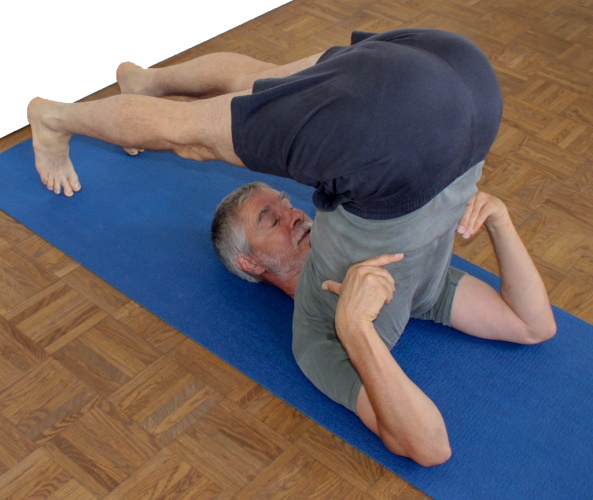
Instructions
- See shoulder stand.
Details
- The transition from halasana to sarvangasana (shoulder stand) is the standard variation described there.
(P)
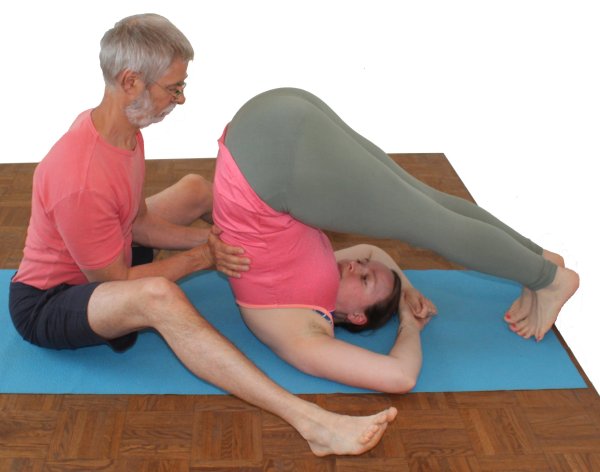
Instructions
- Perform halasana as described above
- The support in halasana consists of several parts:
- The supporter sits behind the back and presses against the upper (cranial) part of the spine to lift it and improve the flexion of the spine so that the rest of the spine can stretch better.
- The supporter grasps the pelvis from the side to straighten it better so that the pelvis comes closer to the vertical. The pelvis is also lifted so that the spine can stretch better.
- The supporter runs one or more fingers along the performer’s spine to determine where vertebrae are still emerging from the body and informs the performer of this. If you can feel the spinous processes protruding, this is a relatively reliable indication that the spine is not yet stretched there, even if the back is clothed.
Details
- Usually, the first and then the second support should be performed first, the third can be performed both before and after the other two.
- For the first support, it is advisable for the supporter to place a fist with the thumb spread out close to the spine and to straighten the back with the thumb from below on a spinous process. On the one hand, this is a stable, less strenuous support due to the fist on the floor, and on the other hand, the responsible muscles, the extensors (extensor pollicis brevis and extensor pollicis longus) and abductors (abductor pollicis brevis and abductor pollicis longus) of the thumb are strong and fine-motor enough to make the thumb very suitable. In doing so, pressure is applied precisely medially and from the cranial side on a spinous process. If the back has straightened up considerably, it may be necessary to switch to the next cranial spinous process.
- Note that in the lumbar spine area, the vertebrae tend to be less prone to exiting anyway due to the physiological lordosis. It is generally interesting to note the extent of any vertebral protrusion in the mid thoracic spine as well as its regularity and the beginning of the disappearance of the vertebrae further towards the pelvis.
- In the case of a pronounced hollow back, the lumbar spine can still remain hollow (concave) despite the tendency of the hamstrings to tilt the pelvis out of the vertical. Conversely, this would be an indication of the presence of a hollow back, at least if the hamstrings is not particularly flexible.
(P) Feet against the wall
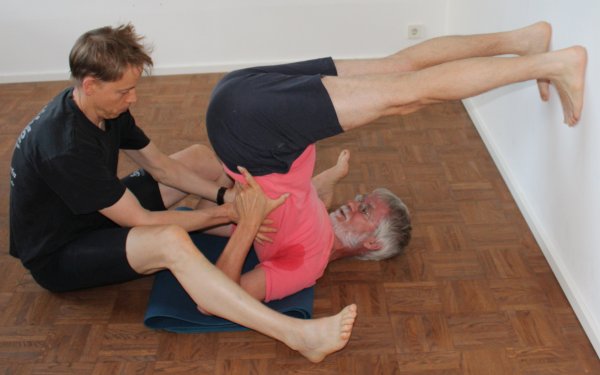
Instructions
- Take the corresponding variant performed alone with the feet on the wall.
- The supporter sits in front of the performer’s back and presses with both hands or both feet on both sides paravertebrally on the erector spinae with a lifting tendency in order to push the back towards the wall and to help stretch it due to the fixed position of the shoulders and pelvis.
Details
- Caution: when leaving the pose, the supporter must make this space available again for rolling the back.
- The supporter must pay attention to and listen for signals that indicate unpleasant tension in the neck muscles.
- The supporter can easily cramp the rectus femoris as a result of the construction of the movement. Then you should push with your hands.
- In this variation, the correct distance between the performer’s shoulders and the wall is very important. If it is too small, there is a risk that the supporter will push him into an incompatible flexion of the cervical spine.
